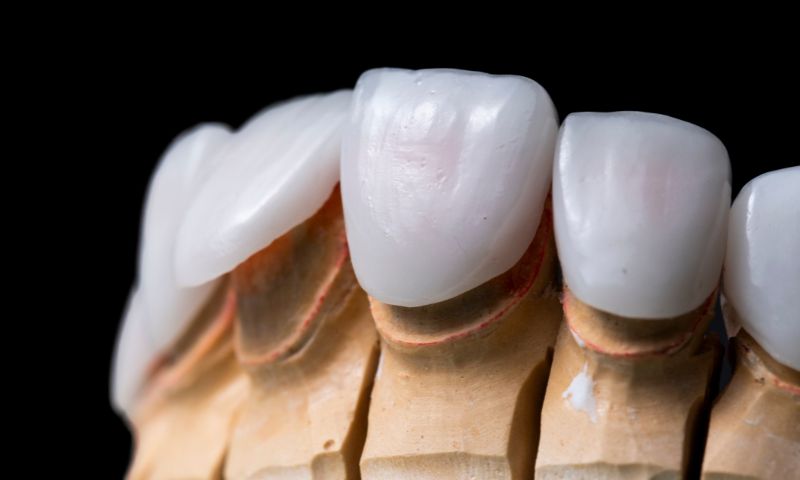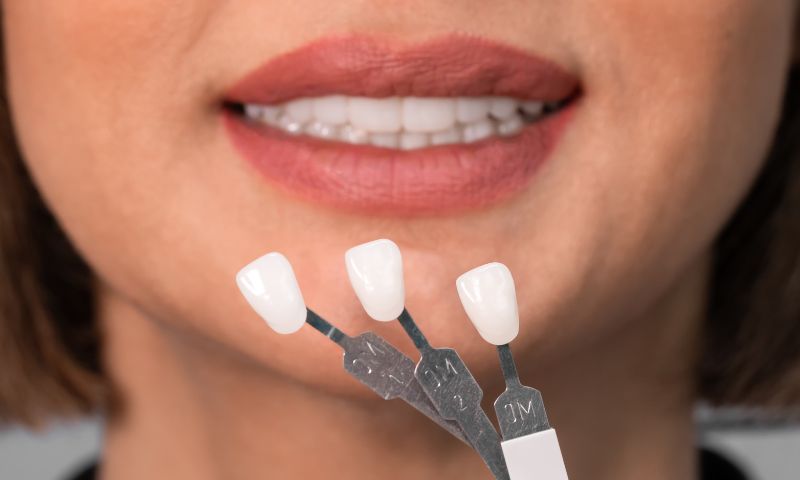Dental Veneers



Dental veneers are an excellent option to improve dental aesthetics. These thin layers of porcelain or composite resin are placed over natural teeth to correct imperfections such as stains, fractures, or misalignments. They are customized to fit each patient perfectly, providing a brighter and more even smile. Additionally, they offer durable and natural results, making them a popular solution for those who want a perfect smile.
Materials used in dental veneers:

Dental veneers are one of the most popular aesthetic solutions to improve the appearance of the smile, and several materials are used in their fabrication, each offering different advantages. The two most common materials are porcelain and composite resin, each with its own specific characteristics and benefits.
Porcelain: Porcelain veneers are the most commonly used due to their aesthetic properties. Porcelain is an extremely durable material and resistant to stains, making it an excellent choice for those seeking long-term results. Additionally, porcelain has a translucency similar to natural tooth enamel, making the veneers look very natural. This material is also biocompatible, meaning it has a low likelihood of causing allergic reactions or gum irritations. Porcelain veneers require a more precise manufacturing process and laboratory time, which generally makes them more expensive than composite resin veneers.
Composite Resin: Composite resin veneers are more affordable compared to porcelain ones. This material is a mix of plastic and glass that is molded directly onto the tooth during the consultation. Although composite resin veneers are not as durable or stain-resistant as porcelain, they have the advantage of being easier to repair in case of damage. Moreover, the placement process is quicker as it does not require a laboratory mold and can be completed in a single session.
Other Materials: In some cases, materials such as feldspathic porcelain or lithium disilicate are used, which also offer excellent aesthetic properties and durability. However, these are less common and are usually employed in more specific situations.
The choice of the right material depends on factors such as budget, aesthetic needs, and the patient’s dental health, and should be determined by the dentist after a thorough evaluation.
Placement process:

The process of placing dental veneers is relatively straightforward, but it requires precision and several stages to ensure a durable, aesthetic, and functional result. Below are the main steps involved in this procedure:
Evaluation and Planning: The first step is a consultation with the dentist, who will assess the general dental health and determine whether veneers are a suitable option for the patient. During this time, the patient’s expectations, the type of material (porcelain or composite resin), and the desired color are discussed.
Tooth Preparation: To place the veneers, the dentist must prepare the tooth. This step involves a small amount of enamel removal, typically between 0.3 to 0.5 millimeters, to ensure the veneer fits perfectly onto the tooth. This procedure is minimally invasive and painless, as it generally does not affect the inner part of the tooth.
Impression Taking: After preparation, the dentist will take precise impressions of the teeth. These impressions will be sent to a dental lab, where the custom veneers will be made. If composite resin veneers are used, this step may not be necessary, as they can be molded directly onto the tooth.
Trial and Adjustment: Once the veneers are ready, the dentist will try them on the patient’s teeth to ensure they fit correctly, both in shape and color. If necessary, adjustments are made to guarantee optimal aesthetics and functionality.
Final Placement: Finally, each veneer is placed on the tooth using a special dental adhesive. After applying the adhesive, the dentist uses a special light to cure the veneers and ensure they are securely bonded.
The process is usually quick, with most people completing the placement in two or three visits to the dentist.
Care and maintenance:

Proper care and maintenance of dental veneers are essential to ensure they remain in good condition over time, preserving both their aesthetics and functionality. While dental veneers are highly durable, they still require proper attention to avoid damage and ensure their longevity.
Daily Oral Hygiene: Proper dental hygiene is crucial for prolonging the lifespan of veneers. It is important to brush your teeth at least twice a day with a non-abrasive toothpaste, as abrasive toothpaste can damage the enamel of the veneers. Additionally, a soft-bristled toothbrush is recommended to avoid scratching the veneers and natural teeth. Flossing is also vital to maintain healthy gums and prevent plaque buildup around the veneers. Using an alcohol-free mouthwash can be beneficial to maintain hygiene and prevent gum issues.
Avoid Harmful Habits: Patients with dental veneers should avoid habits that could damage them. Biting hard objects like pens, ice, or opening packages with your teeth can cause the veneers to chip or detach. Additionally, people who play contact sports should consider using a mouthguard to protect the veneers from potential impact.
Avoid Staining Foods and Drinks: While porcelain veneers are resistant to stains, composite resin veneers may be more susceptible to discoloration over time. Foods and beverages like coffee, tea, red wine, and curry can cause stains. It’s advisable to limit the consumption of these items, or rinse your mouth after consuming them to prevent stains from adhering to the veneers.
Regular Dentist Visits: Periodic check-ups with the dentist are essential to ensure that the veneers remain in good condition. The dentist can check for signs of wear or damage and make adjustments or repairs if necessary. If a veneer becomes loose or cracked, it is important to consult the dentist as soon as possible to avoid further complications.
Replacement and Repair: Over time, veneers may need to be replaced or repaired. While porcelain veneers are quite durable, composite resin veneers may show signs of wear more quickly, such as loss of shine or discoloration. In case of damage, composite resin veneers can be repaired more easily, while porcelain ones may require remanufacturing.
With proper care, dental veneers can last many years, providing a bright and natural smile. It is essential to follow the dentist’s recommendations to keep them in optimal condition and prevent long-term issues.
Benefits of Dental Veneers:
Dental veneers improve dental aesthetics by correcting stains, fractures, or misalignments. They offer natural, long-lasting, and stain-resistant results, resulting in a brighter, more uniform smile, which increases confidence and quality of life.

- They improve dental aesthetics.
- Corrigen manchas y fracturas.
- They offer natural results.
- They are durable and stain resistant.
- They increase confidence and self-esteem.
¿Qué son las carillas dentales?
They are thin sheets of porcelain or composite resin that are placed over the teeth to improve their appearance.
How long do dental veneers last?
With proper care, they can last 10 to 15 years..
Do dental veneers hurt when they are placed?
No, the process is generally painless, although there may be some temporary tenderness after treatment.
Are dental veneers permanent?
Yes, they are durable, but they will eventually need to be replaced over time.
Can I eat normally with dental veneers?
Yes, but it is advisable to avoid very hard or sticky foods to prevent damage.
We always take care of your smile.
614 415 8236 Call us and schedule your appointment

